第七章 同源四倍体讲课讲稿
- 格式:ppt
- 大小:5.37 MB
- 文档页数:56
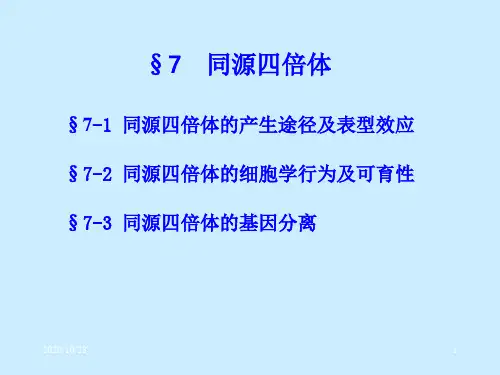

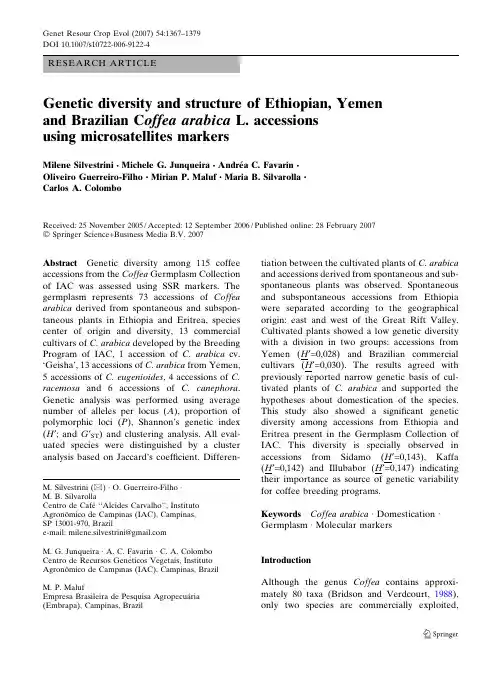
Abstract Genetic diversity among 115coffee accessions from the Coffea Germplasm Collection of IAC was assessed using SSR markers.The germplasm represents 73accessions of Coffea arabica derived from spontaneous and subspon-taneous plants in Ethiopia and Eritrea,species center of origin and diversity,13commercial cultivars of C.arabica developed by the Breeding Program of IAC,1accession of C.arabica cv.‘Geisha’,13accessions of C.arabica from Yemen,5accessions of C.eugenioides ,4accessions of C.racemosa and 6accessions of C.canephora .Genetic analysis was performed using average number of alleles per locus (A ),proportion of polymorphic loci (P ),Shannon’s genetic index (H ¢;and G ¢ST )and clustering analysis.All eval-uated species were distinguished by a cluster analysis based on Jaccard’s coefficient.Differen-tiation between the cultivated plants of C.arabica and accessions derived from spontaneous and sub-spontaneous plants was observed.Spontaneous and subspontaneous accessions from Ethiopia were separated according to the geographical origin:east and west of the Great Rift Valley.Cultivated plants showed a low genetic diversity with a division in two groups:accessions from Yemen (H ¢=0,028)and Brazilian commercial cultivars (H ¢=0,030).The results agreed with previously reported narrow genetic basis of cul-tivated plants of C.arabica and supported the hypotheses about domestication of the species.This study also showed a significant genetic diversity among accessions from Ethiopia and Eritrea present in the Germplasm Collection of IAC.This diversity is specially observed in accessions from Sidamo (H ¢=0,143),Kaffa (H ¢=0,142)and Illubabor (H ¢=0,147)indicating their importance as source of genetic variability for coffee breeding programs.Keywords Coffea arabica ÆDomestication ÆGermplasm ÆMolecular markersIntroductionAlthough the genus Coffea contains approxi-mately 80taxa (Bridson and Verdcourt,1988),only two species are commercially exploited,M.Silvestrini (&)ÆO.Guerreiro-Filho ÆM.B.SilvarollaCentro de Cafe´‘‘Alcides Carvalho’’,Instituto Agronoˆmico de Campinas (IAC),Campinas,SP 13001-970,Brazile-mail:milene.silvestrini@M.G.Junqueira ÆA.C.Favarin ÆC.A.ColomboCentro de Recursos Gene´ticos Vegetais,Instituto Agronoˆmico de Campinas (IAC),Campinas,Brazil M.P.MalufEmpresa Brasileira de Pesquisa Agropecua´ria (Embrapa),Campinas,BrazilGenet Resour Crop Evol (2007)54:1367–1379DOI 10.1007/s10722-006-9122-4RESEARCH ARTICLEGenetic diversity and structure of Ethiopian,Yemen and Brazilian C offea arabica L.accessions using microsatellites markersMilene Silvestrini ÆMichele G.Junqueira ÆAndre ´a C.Favarin ÆOliveiro Guerreiro-Filho ÆMirian P.Maluf ÆMaria B.Silvarolla ÆCarlos A.ColomboReceived:25November 2005/Accepted:12September 2006/Published online:28February 2007ÓSpringer Science+Business Media B.V.2007Coffea arabica L.and Coffea canephora Pierre ex Froehner.C.arabica is an autogamous species and the only allotetraploid(2n=4x=44)of the genus while the other species are diploids(2n=2x =22)and generally self-incompatible(Krug and Carvalho,1951). C.arabica is native of the highlands of Ethiopia(Sylvain,1955),but there are also records of wild arabica coffee in the Boma Plateau of Sudan(Thomas,1942)and Mount Marsabit of Kenya(Berthaud and Charrier,1988).The arabica coffee cultivation started in Arabia, specifically in Yemen,five centuries ago.In the early 18th century,progenies from a single Indonesia plant cultivated in Europe were spread out to South America and turned out to be the genetic basis of main cultivars of Brazil and other countries (Chevalier and Dagron,1928;Carvalho,1945).In view of this narrow genetic basis and the necessity of genetic resources conservation,FAO organized in1964–65a mission to collect sponta-neous and subspontaneous coffee germplasm in probable native regions of the species(FAO, 1968).This initiative resulted in621samples of seeds from various collecting sites in Ethiopia and the Republic of Eritrea which were carefully documented and sent to six institutions in India,Tanzania,Ethiopia,Costa Rica,Peru and Portugal for further research(FAO,1968).The accessions represented in the Coffee Germplasm Collection of Instituto Agronoˆmico de Campinas(IAC)include plant material orig-inated from308of those seed sample,obtained from plants of the Centro Agrono´mico Tropical de Investigacio´n y Ensen˜anza(CATIE)at Turri-alba,Costa Rica,collected in the years1973and 1987.There is also a substantial number of cultivated coffee germplasm in the IAC’s collec-tion.Besides this,several samples of plants from Yemen were introduced by A.B.Eskes,a researcher from IRCC,Montpellier,after a detailed morphologic and agronomic character-ization(Eskes and Mukred,1990).Since their introduction at IAC,all those materials are under continuous evaluation regard-ing botanic,agronomic,and technologic aspects (Carvalho et al.,1983;Mazzafera et al.,1990; Silvarolla et al.,2000).However,despite all these studies,the degree of genetic diversity and structure of the IAC collection is poorly under-stood.In order to fulfill this analysis,molecular markers could help reveal the structure of genetic diversity,which is an important information for setting up a core collection and to improve the conservation,accessibility and use of genetic resources of this collection(Hamon et al.,1999).Previous studies have already evaluated the genetic diversity of some Ethiopian and FAO accessions through morphologic and agronomic characteristics(Montagnon and Bouharmont, 1996),RAPD markers(Lashermes et al.,1996; Anthony et al.,2001;Chaparro et al.,2004;Aga et al.,2003)and ISSR markers(Aga et al.,2005). However,in these studies only few accessions from Yemen were analyzed(Montagnon and Bouharmont,1996;Lashermes et al.,1996; Anthony et al.,2002)and were reported different results regarding grouping and genetic structure of those accessions collected in different regions from Ethiopia and Yemen.Chaparro et al.(2004) did not found an association between grouping and the site of origin in Ethiopia.Montagnon and Bouharmont(1996)showed that there is a sepa-ration between coffee trees growing east and west of the Great Rift Valley,with accessions from south–eastern and southern of Ethiopia being grouped together with cultivated plants from Yemen.Anthony et al.(2001)and Aga et al. (2003,2005)also distinguished eastern and western groups in accessions from Ethiopia,but with a low genetic differentiation between them and cultivated plants arising as a group apart (Anthony et al.,2001).Microsatellites markers(SSR)have shown good efficiency to assess genetic diversity and relationships among coffee trees(Moncada and McCouch2004;Maluf et al.,2005).Thus,we thought SSR could be an alternative tool to elucidate the questions about genetic structure of C.arabica as well to characterize diversity levels of genetic resources included in the Coffea Germplasm Collection of IAC.Further-more,this is thefirst study analyzing a repre-sentative sample of both materials collected from the center of the origin and diversity of the C.arabica species and cultivated plants from Yemen and Brazil through microsatellites markers.Material and methods Plant materialThe evaluated plant material consisted of 115coffee accessions from the Coffea Germplasm Collection of IAC.These included 73accessions of C.arabica L.derived from spontaneous and subspontaneous trees from various regions of Ethiopia and Eritrea (Fig.1),13accessions of C.arabica from Yemen,1accession of C.arabica cv.‘Geisha’(Table 1),and 13commercial culti-vars of C.arabica developed by the IAC Breed-ing Program (Table 2).Also,5accessions of C.eugenioides S.Moore,4accessions of C.racemosa Lour.and 6accessions of Coffea canephora Pierre ex Froehner were included as outgroup species due to their importance in the evolutionary history of coffee and as source of target genes for breeding programs.Sampling of spontaneous and subspontaneous accessions from Ethiopia and Eritrea was representative of total accession number at the Germplasm Collection of IAC.Genomic DNA extractionTotal genomic DNA was extracted from frozen young leaves according to Stewart Jr.and Via (1993),using CTAB as detergent.All DNA samples were diluted to a final concentration of 20ng/l l.SSR amplificationPrimer sequences to amplify SSR locus were obtained from Combes et al.(2000)and Rovelli et al.(2000)(Table 3).Final reaction conditions were 40ng of genomic DNA, 1.5·reaction buffer,0.1mmol l –1of dNTP,2mmol l –1of MgCl 2,5q mol of each primer and 1.5U of Taq DNA polymerase.The complete thermal cycle program was 5min at 95°C,followed by 30cycles of 1min at 95°C,1min at 60°C and 1min at 72°C,and a final 5min of elongation time at 72°C.Primers were fluorescently labelled and ampli-fied products were separated on a 5%acrylamide gel using an ABI 377automatedsequencerFig.1Collecting sites of Coffea arabica accessions evaluated.Ethiopia political organization is according to FAO (1968),except by separation of Eritrea(Applied Biosystems).Products were detected by the applicative Gene Scan(Applied Biosys-tems)using internal molecular size markers (GENESCAN-500ROX),and analyzed by the applicative Genotyper v 2.0(Applied Biosys-tems).Table1List of Coffea arabica accessions from the Coffea Germplasm Collection of IAC analyzed through SSR markers.‘‘E’’identifies material collected in Ethiopia and Eritrea by FAO and‘‘T’’identifies material from the CATIE’s collection.Spontaneous(spont)and subspontaneous-derived(sub)material originated from single plant,random or representative sample according to FAO(1968)Origin SampleCode Accession CollectionnumberType Origin SampleCodeAccession CollectionnumberTypeHarar HA1IAC2026E12/T4950Random sample sub Kaffa KA23IAC3929E336/T4594Single sub HA2IAC2025E7/T4472Random sample sub KA24IAC3930E345/T4603Single subSidamo SI1IAC2029E18/T4474Random sample sub KA25IAC3948E142/T4663Single spont SI2IAC2102E237/T4758Representativesample subKA26IAC3949E143/t4664Single spontSI3IAC2032E22/T4476Random sample sub KA27IAC3952E468/T4691Single subSI4IAC2030E19/T4475Random sample sub KA28IAC3950E144/T4665Single spontSI5IAC2031E21/T4953Random sample sub KA29IAC3954E188/T4693Two plants sub SI6IAC2028E17/T4473Random sample sub KA30IAC3955E311/T4699Single subShoa SH1IAC2027E16/T4951Random sample sub KA31IAC3959E385/T4784Single sub SH2IAC2035E36/T4500Random sample sub KA32IAC3960E388/T4787Single subSH3IAC2036E37/T4501Random sample sub KA33IAC3965E396/T4803Single subEritrea ER IAC2207E579/T4945Random sample sub KA34IAC3968E411/T4811Single subGojjam GO1IAC2205E571/T4939Single sub KA35IAC3972E418/T4818Single sub GO2IAC2202E558/T4926Single sub Illubabor IL1IAC3986E453/T4853Single spontGO3IAC2206E572/T4940Single sub IL2IAC3985E448/T4848Single spontGO4IAC2204E565/T4933Single sub IL3IAC3984E446/T4846Single spontGO5IAC2203E563/T4931Single sub IL4IAC3983E445/T4845Single spontGO6IAC4008E559/T4927Single sub IL5IAC3981E438/T4838Single spontGO7IAC4009E560/T4928Single sub IL7IAC3979E436/T4836Single spontGO8IAC4010E561/T4929Single sub IL8IAC3976E425/T4825Single spontGO9IAC4011E562/T4930Single sub IL9IAC3975E424/T4824Single spontGO11IAC4013E578/T4944Single sub IL10IAC3843E431/T4831Single spontGO12IAC4015E577/T4959Single sub IL11IAC3849E465/T4865Single spontKaffa KA1IAC3814E134/T4568Random sample sub IL12IAC3934E358/T4631Single sub KA2IAC3818E328/T4586Single sub IL13IAC3935E361/T4634Single subKA3IAC3832E226/T4749Single sub IL14IAC3936E366/T4639Single subKA4IAC3856E531/T4900Single sub IL15IAC3937E367/T4640Single subKA5IAC3838E380/T4795Single sub IL16IAC3938E369/T4642Single subKA6IAC3995E522/T4889Single sub IL17IAC3940E373/T4646Single subKA7IAC3998E536/T4905Single subKA8IAC3999E539/T4908Single spont Geisha(cv)GE IAC2210T4305Cultivated fromMalawi KA9IAC4000E542/T4911Single sub Yemen YE1IAC4113Cultivated-Localtype KA10IAC4001E543/T4912Single sub YE2IAC4114Cultivated-Localtype KA11IAC4002E547/T4916Single sub YE4IAC4116Cultivated-Tessawi KA12IAC3804E307/T4485Single sub YE5IAC4117Cultivated-Tessawi KA13IAC3839E412/T4812Single sub YE6IAC4118Cultivated-Essaii KA14IAC3913E495/T4533Single sub YE8IAC4120Cultivated-Essaii KA15IAC3915E300/T4546Single sub YE10IAC4122Cultivated-Tessawi KA16IAC3916E474/T4547Single sub YE11IAC4123Cultivated-Odaynii KA17IAC3917E475/T4548Single sub YE12IAC4124Cultivated-Localvariant KA18IAC3919E480/T4553Single sub YE13IAC4125Cultivated-Localvariant KA19IAC3920E488/T4560Single sub YE14IAC4126Cultivated-Tessawi KA20IAC3921E491/T4564Single sub YE15IAC4127Cultivated-Katii KA22IAC3926E150/T4573Single sub YE16IAC4128Cultivated-KatiiTable2List of commercial Coffea arabica cultivars developed by IAC evaluated through SSR markersCultivar Sample code OriginAcaia´IAC474-4AC474-4Bourbon Vermelho·Sumatra(Typica)Mundo Novo IAC388-17MN388-17Bourbon Vermelho·Sumatra(Typica)Bourbon Amarelo IAC J19BA Bourbon Vermelho(mutation)Catuaı´Vermelho IAC81CV81Caturra Amarelo476·Mundo Novo374-19Catuaı´Vermelho IAC144CV144Caturra Amarelo476·Mundo Novo374-19Catuaı´Amarelo IAC100CA100Caturra Amarelo476·Mundo Novo374-19Icatu Vermelho IAC4042IV4042(C.canephora cv.Robusta·Bourbon Vermelho)·Mundo Novo Icatu Vermelho IAC4045IV4045(C.canephora cv.Robusta·Bourbon Vermelho)·Mundo Novo Icatu Vermelho IAC4046IV4046(C.canephora cv.Robusta·Bourbon Vermelho)·Mundo Novo Icatu Amarelo IAC2944IA Icatu Vermelho·Bourbon AmareloOuro Verde IAC H5010-5OV Catuaı´Amarelo·Mundo Novo515Obata˜IAC1669-20OB(Villa Sarchi·Hybrid of Timor)·Catuaı´VermelhoTupi IAC1669-33TP(Villa Sarchi·Hybrid of Timor)·Catuaı´VermelhoTable3Access number of microsatellite loci in the‘‘Genbank’’,locus code and respective forward(F)and reverse(R) primer sequencesAcession number Locus code Sequence of primers(5‘–3’)Repeated sequenceAJ3087384-1CTG F=AAAAAGCTGGTCCATGTCAA(TG)8(SSR5)R=GGGGCGTTCAGTTATAAACAAJ30874617-2CTG F=AGGCCTTCATCTCAAAAACC(TC)14/(CA)11/(CA)16(SSR6)R=AGCGTTACTTGAGGCAAAGAAJ308762E6-3CTG F=CTGGGTTGGTTCTGATTTTG(TG)16(SSR7)R=GGTTCCCAGAGATTCTCTCCAJ308767E12-3CTG F=TGCTTAGGCACTTGATATAGGA(CA+TA)38(SSR9)R=CACGTGCAAGTCACATACTTTAAJ308785I9-3CTG F=TGGCCGTGATAATAAACAGC(TG)21(SSR11)R=ATGTGGCAATCTAAAGCCAAAJ250258M32F=AACTCTCCATTCCCGCATTC(CA)3/(CA)3/(CA)18(SSR14)R=CTGGGTTTTCTGTGTTCTCG–C2-2CATC F=CTCTCCCTCAGTCAATTCCA(ATC)14(SSR15)R=CTTGGTCTCCCTCCTTTTTCAJ30875432-2CTG F=AAGGGGAGTGGATAAGAAGG(CA)12(SSR17)R=GGCTGGATTTGTGCTTTAAGAJ308764E8-3CTG F=CACTGGCATTAGAAAGCACC(CA)14(SSR18)R=GGCAAAGTCAATGATGACTCAJ250251M3F=ATTCTCTCCCCCTCTCTGC(CA)6/(CA)3/(CA)3/(CA)3/ (SSR20)R=TGTGTGCGCGTTTTCTTG(CA)4/(CA)3/(CA)3/(CA)3AJ250252M11F=ACCCGAAAGAAAGAACCAAG(GT)4/(GA)4/(GT)4/(GT)6 (SSR21)R=CCACACAACTCTCCTCATTCAJ250253M20F=CTTGTTTGAGTCTGTCGCTG(GA)5/(GT)8/TT(GT)4/TT (SSR22)R=TTTCCCTCCCAATGTCTGTA(GT)7/(GA)11/(TC)2/(CT)3GT AJ250255M25F=CCCTCCCTGCCAGAAGAAGC(GT)5/CT(GT)2/(GT)12(SSR24)R=AACCACCGTCCTTTTCCTCGAJ250256M27F=AGGAGGGAGGTGTGGGTGAAG(GT)11(SSR25)R=AGGGGAGTGGATAAGAAGGAJ250257M29F=GACCATTACATTTCACACAC(CTCACA)4/(CA)9(SSR26)R=GCATTTTGTTGCACACTGTAAJ250260M47F=TGATGGACAGGAGTTGATGG(CT)9/(CA)8/(CT)4/(CA)5 (SSR27)R=TGCCAATCTACCTACCCCTTData analysisGels were scored by presence or absence of bands or alleles.Due to the tetraploid condition of C.arabica,it is impossible to distinguish between diallelic duplex and simplex and among different types of triallelic combinations of SSR loci. Therefore,for each individual plant,fragment frequencies were analyzed as multilocusfinger-prints,in which each allele was either scored present or absent.Genetic diversity within groups of C.arabica and within diploids species was evaluated by average number of alleles per locus(A),propor-tion of polymorphic loci(P)and the Shannon’s genetic index(H¢)(Bussel,1999).Groups of C.arabica consisted of accessions of the same collecting region(Table1)and commercial culti-vars developed by IAC.Cultivar‘Geisha’was excluded of the genetic diversity analysis because it was represented by only one accession/group. Estimation of A was an exception to the multilo-cusfingerprints approach once amplified products of each pair of primers were considered as alleles of the same locus.P was calculated dividing the number of polymorphic bands by total number of amplified bands in each group.Shannon’s genetic index for each marker was calculated for each group as:H¢=-Pp i*log2p iwhere p i is the frequency of the presence or absence of a band in that group.Following the method of Bussel(1999),the partitioning of genetic variation within and between groups of C.arabica was estimated.The average diversity over all populations for each locus(H¢pop)and the total diversity in the99 accessions of C.arabica for each locus(H¢sp)were calculated(for more details see Bussel,1999).Then the component of diversity within populations (H¢pop/H¢sp)and the component between popula-tions(G’ST=(H¢sp–H¢pop)/H¢sp)were estimated.H¢,H¢pop,H¢sp and G¢ST were the average values per locus calculated over all loci,including monomorphic ones,according to Bussel(1999). We categorized the partitioning of genetic diver-sity analysis according to the groups of accessions analyzed.These groups included all accessions (Analysis1),all accessions without Eritrea group (Analysis2),spontaneous and subspontaneous accessions(Analysis3)and spontaneous and subspontaneous accessions without Eritrea group (Analysis4).Eritrea group was excluded from Analysis2and4to improve understanding of species genetic structure.This was carried out because Eritrea group contains just one individual and this could lead to bias G¢ST values by decreasing H¢pop.Genetic distance among all accessions(includ-ing C.arabica cv.‘Geisha’)was estimated as the complement of Jaccard’s(1908)coefficient(Link et al.,1995).Genetic distances were also esti-mated using Dice coefficient(Dice,1945),which is equivalent to Nei and Li(1979),in order to compare values with other studies.Cluster anal-ysis was performed using the matrix distance based on the complement of Jaccard’s coefficient employing the UPGMA method.Bootstrap anal-ysis(Felsenstein,1985)was performed to evalu-ate the tree topology reliability for1,000 simulations using the software Treecon(Van de Peer and Watcher,1994).ResultsThe multilocusfingerprints approach was used to analyze the genetic diversity and structure of coffee accessions.In spite of this,specific results for each primers pairs were pointed out for characterization of individual SSR locus.SSR locus characterizationThe E12-3CTG(SSR9)locus showed a profile with3and4peaks even in diploid species such as C.canephora and C.eugenioides.The 4-1CTG(SSR5)locus was monomorphic(band of97bp)in C.arabica and C.eugenioides and did not amplify any fragment in C.racemosa and C.canephora species.Primers E6-3CTG, E8-3CTG and M3also amplified monomorphic bands within C.arabica accessions(a total of12 bands),and those were polymorphic among evaluated species.Genetic diversitySixteen SSR primers pairs produced a total of121 bands or alleles.All tested markers detected polymorphisms among the accessions evaluated, being54bands among C.arabica accessions and15bands among cultivated plants(Yemen,‘Geisha’and Brazilian cultivars).Also,7out of54 polymorphic bands of C.arabica,were present at high frequencies(0.8or more),31as rare alleles in low frequency(0.2or less)and16with frequencies between0.2and0.8.Genetic diversity analysis showed the highest values of H¢in diploid species(Table4).Values for A in diploid species were similar or even lower than those observed in C.arabica groups,prob-ably due to the allotetraploid nature of C.arabica which results in duplicate A values per plant.H¢values were relatively high in accessions from Kaffa,Illubabor and Sidamo provinces,moderate in Gojjam and Harar,and very low in cultivated plants.The P index was higher in diploid species and within Kaffa and Illubabor groups.The discrepancy of H¢relative to A and P values in Kaffa and Illubabor groups occurred due to the presence of rare alleles(Table4).Genetic distances ranged from0to0.88 between all possible pairs of genotypes,from0 to0.37among C.arabica accessions,from0to 0.30among spontaneous and subspontaneous accessions from Ethiopia and Eritrea,and from 0to0.19among cultivated accessions(Fig.1). Genetic distances among C.arabica accessions were also calculated using only the polymorphic bands exclusive to C.arabica(44.6%of total fragments).Results showed that this distance ranged from0to0.65using Jaccard’s coefficient or its complement and from0to0.49using Dice’s coefficient.Genetic structureG¢ST values showed a strong genetic structure in all accessions of C.arabica(Table5).A strong genetic structure was also observed in spontane-ous and subspontaneous accessions from Ethio-pian.Exclusion of group Eritrea,which contains just one individual,increased H¢pop values and decreased G¢ST values but yet results showed the strong genetic structure in the evaluated acces-sions(Table5).The hierarchical clustering analysis presented in Fig.2showed four major clusters comprising grouped accessions of each species.The analysis of species relationships showed C.canephora closer to C.arabica,followed by C.eugenioides. Also, C.racemosa was distantly related to C.arabica.Grouping of C.arabica accessions(Fig.2) revealed two main clusters.Thefirst contains only cultivated plants,including the accessions of Yemen,cultivar‘Geisha’and commercial cultivars from Brazil.An exception was the accession of Sidamo(SI4)also included in this group with materials from Yemen.Yemen accessions of type Tessawi(Table1)were distinguished from the others in a separated cluster.The second group encompassed basically all spontaneous and sub-spontaneous accessions from Ethiopia and Eri-trea.Despite the low boostrap values(Fig.2), there was a clear separation of these accessions in two large subgroups:thefirst included mainlyTable4Genetic diversity within species and groups of coffee species assessed by average number of alleles per locus(A),proportion of polymorphic loci(P) and Shannon’s genetic index averaged over all loci(H¢)Species Group A P(%)H¢Coffea arabica Harar(HA) 2.3 5.00.050Sidamo(SI) 2.716.50.143Shoa(SH) 2.512.40.115Eritrea(ER) 2.0––Gojjam(GO) 2.513.20.087Kaffa(KA) 3.224.80.142Illubabor(IL) 3.124.00.147Yemen(YE) 2.2 5.00.028Commercial cultivars 2.0 4.10.030 Coffea eugenioides 2.529.80.242 Coffea canephora 2.824.60.197 Coffea racemosa 2.120.70.200accessions from Sidamo and the second subgroup included all other accessions from the west side of the Great Rift Valley.DiscussionSSR locus characterizationIn general,the amplification patterns for each SSR locus evaluated corresponded to those pre-viously reported.The profile of E12-3CTG (SSR9)locus with3and4peaks in the diploid species C.canephora and C.eugenioides con-firmed that this pair of primers amplified a number of independent loci(Rovelli et al., 2000).Considering this,E12-3CTG locus has not been used to estimate number of alleles per locus(A).The locus4-1CTG(SSR5)was monomorphic in C.arabica and C.eugenioides and did not amplify any fragment in C.racemosa and C. canephora species.According Rovelli et al.(2000) this locus showed diploid type segregation in C. arabica.Thus,it is probable that the amplification has just occurred in putative genome provided by C.eugenioides(Lashermes et al.,1999).However, in other analysis Poncet et al.(2004)using different primer sequences to amplify this same SSR locus identified a monomorphic band of 239bp also in C.canephora and other diploid species,including C.eugenioides.This new primer pair amplified the total SSR sequence present at GENBANK,while Rovelli et al.(2000)’s primers amplified only part of the SSR sequence.These results suggested that the4-1CTG locus is present in C.arabica, C.eugenioides and C.canephora and other Coffea species(see Poncet et al.,2004).However,there is an interspecific polymorphism in theflanking regions of SSR that prevent amplification in C.canepho-ra,C.racemosa and in the putative C.canephora genome of C.arabica(Lashermes et al.,1999). Interestingly,Rovelli et al.(2000)identified heterozygotes in the accessions of C.arabica var.Caturra showing a polymorphism in repeat motifs within cultivated plants of C.arabica that was not observed in our study.Genetic diversityThe high variability detected in spontaneous and subspontaneous accessions of C.arabica was observed mainly in coffee trees from Sidamo, Kaffa and Illubabor provinces although it also must be noted that50%of accessions were sampled from Kaffa and Illubabor regions. Significant levels of genetic diversity in coffee plants from Kaffa and Illubabor were also reported by Anthony et al.(2001)and Chaparro et al.(2004).Indeed,the high variability among accessions from these regions in the collections is a consequence of the great effort in collecting samples with as much visual,botanical and agronomical diversity as possible(FAO,1968). The high genetic diversity detected in Sidamo accessions could be visualized by the proportion of shared alleles among genotypes within both divergent groups of C.arabica,cultivated plants and spontaneous and subspontaneous accessions from Ethiopia.Comparing the genetic distance values among C.arabica accessions,we found values similar to those reported by Orozco-Castillo et al.(1994), Anthony et al.(2001,2002),but lower values than Moncada and McCouch(2004).Genetic diversity evaluated by allele distribution(29.6%of alleles Fig.2Dendrogram of the115Coffea accessions listed in Tables1and2based on Jaccard genetic distance obtained from SSR markers using the UPGMA method.Numbers (%)on the branches correspond to bootstrap values above 50%(1,000replications).Letters indicate the geographical origin of accessions:W(West of the Great Rift Valley) and E(East of the Great Rift Valley)cTable5Partitioning of genetic diversity generated by121 SSR bands within and between groups of Coffea arabica accessions.H¢pop,H¢sp and G¢ST are the average per locus values allGroups analyzed H¢pop H¢sp G¢ST(1)All accessions0.0820.2100.577(2)All accessions without Eritrea0.0930.2100.526(3)Spontaneous and subspontaneousaccessions0.0980.1790.464 (4)Spontaneous and subspontaneousaccessions without Eritrea0.1140.1750.349with frequencies between0.2and0.8)revealed a diversity degree intermediate between that iden-tified by Anthony et al.(2001)and that found by Chaparro et al.(2004),with17and39.6%of alleles with frequencies between0.2and0.8, respectively.Proportion of polymorphic loci and Shannon’s index values estimated in this study can be considered in the same range of a similar analysis of arabica coffee in natural populations from Ethiopia(Aga et al.,2003).These authors determined P and H¢values ranging from37% to73%and0.2to0.4,respectively,in9plants per population.However,P and H¢were calcu-lated based on C.arabica amplified bands while in the present study all amplified bands,includ-ing those specific of diploid species and mono-morphic to C.arabica were included in the index calculation.On the other hand,if only C.arabica amplified bands were considered for calculating P and H¢values,these would be for Kaffa group,for example,P=55.6%and H¢= 0.328,identical to that observed by Aga et al. (2003).Besides this,observed values of genetic distances among accessions were similar in both studies.Therefore,these results suggest that there is a significant genetic diversity in the coffee collec-tion of IAC.Furthermore,the genetic diversity estimated for Ethiopian accessions was higher than that of cultivated plants.Thus there is a large variation that can be source for introgression of desirable characteristics in commercial cultivars that has already been used by the coffee breeding program of IAC(Bettencourt and Carvalho, 1968;Moraes et al.,1974;Fazuoli,1981;Silvarolla et al.,2004).Genetic structureResults of amplification of4-1CTG locus in C.arabica,C.eugenioides and C.canephora and analysis of species relationship observed in this work are in agreement with the hypothesis about the botanic origin of C.arabica species as a natural hybrid between C.canephora and C.eugenioides(Lashermes et al.,1999).Despite contrasting results concerning which of both species is closer to C.arabica,several molecular markers as well as phylogenetics studies have recognized C.canephora and C.eugenioides closer related to C.arabica than other Coffea species(Lashermes et al.,1993,1997;Cros et al., 1998;Ruas et al.,2000,2003).These diversity analyses also identified C.racemosa as the most genetically distant species of C.arabica.According to Bussel(1999)calculation of G’ST using the Shannon’s index are in accordance with G ST estimated by other methods,such as AMOVA and modified F-statistics.Also,G’ST is a good estimate to evaluate genetic structure of tetraploid,autogamous collections such as this of C.arabica plants,where heterozygosity cannot be assessed and Hardy–Weinberg equilibrium assumptions cannot be considered.G’ST values of C.arabica observed in this workfitted into expected values based on the breeding system.In that case,according to Bussel(1999),G’ST values for autogamous species from natural populations is around60%and around15%for allogamous species.Results of G¢ST for C.arabica accessions associated with cluster analysis indicated a strong genetic structure in the species.Therefore,the genetic diversity was observed among groups rather than within groups.Cluster analysis clearly showed the separation of cultivated plants from Ethiopian and Eritrean spontaneous and sub-spontaneous accessions.Besides,the analysis allowed distinguishing a morphologic type of Yemen(Tessawi)and Yemen accessions from Brazilian cultivars,although both groups exhib-ited a very low genetic diversity.These results are in agreement with the well-described narrow genetic basis of cultivated plants of C.arabica (Lashermes et al.,1996;Anthony et al.,2001; Moncada and McCouch2004;Maluf et al.,2005) and historical data.Brazilian coffee originated from a few plants introduced in the early18th century and these plants were originated from the first cultivated plants in Yemen(Chevalier and Dagron,1928;Carvalho,1945).Partitioning of genetic diversity of the sponta-neous and subspontaneous accessions showed a lower value of G¢ST(0.464)than that observed when all accessions were analyzed.However,the G¢ST value still indicated a strong genetic struc-ture in these accessions.Hence,accessions of。
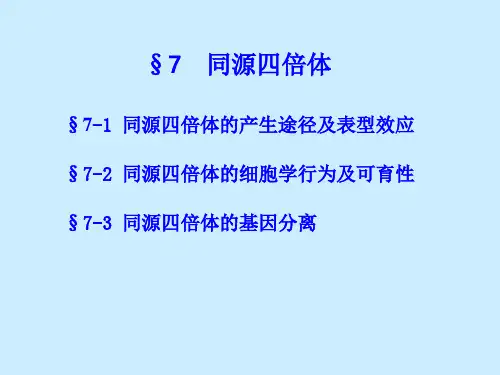
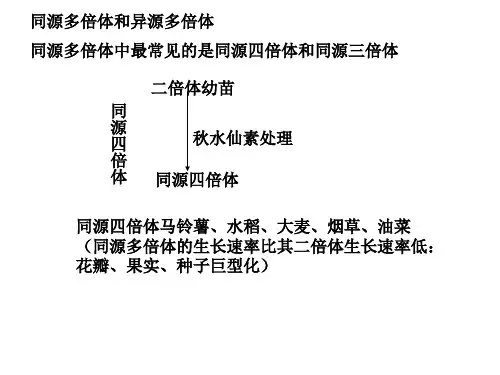
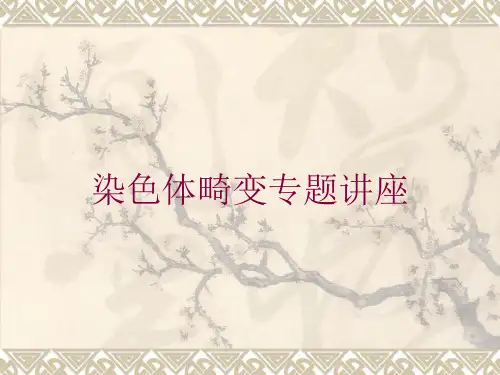

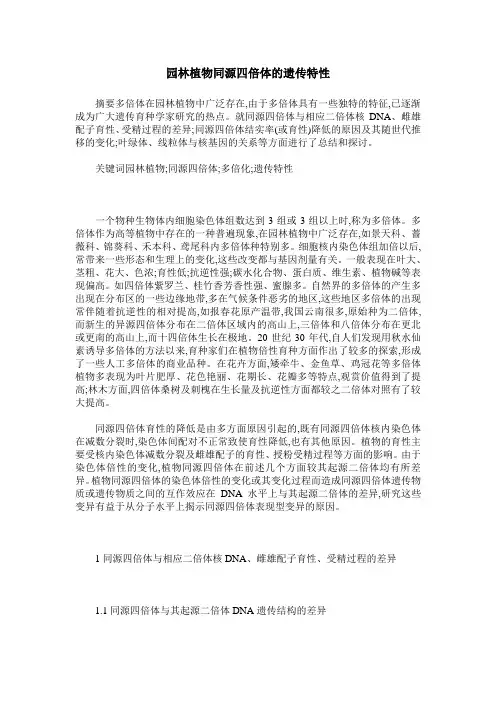
园林植物同源四倍体的遗传特性摘要多倍体在园林植物中广泛存在,由于多倍体具有一些独特的特征,已逐渐成为广大遗传育种学家研究的热点。
就同源四倍体与相应二倍体核DNA、雌雄配子育性、受精过程的差异;同源四倍体结实率(或育性)降低的原因及其随世代推移的变化;叶绿体、线粒体与核基因的关系等方面进行了总结和探讨。
关键词园林植物;同源四倍体;多倍化;遗传特性一个物种生物体内细胞染色体组数达到3组或3组以上时,称为多倍体。
多倍体作为高等植物中存在的一种普遍现象,在园林植物中广泛存在,如景天科、蔷薇科、锦葵科、禾本科、鸢尾科内多倍体种特别多。
细胞核内染色体组加倍以后,常带来一些形态和生理上的变化,这些改变都与基因剂量有关。
一般表现在叶大、茎粗、花大、色浓;育性低;抗逆性强;碳水化合物、蛋白质、维生素、植物碱等表现偏高。
如四倍体紫罗兰、桂竹香芳香性强、蜜腺多。
自然界的多倍体的产生多出现在分布区的一些边缘地带,多在气候条件恶劣的地区,这些地区多倍体的出现常伴随着抗逆性的相对提高,如报春花原产温带,我国云南很多,原始种为二倍体,而新生的异源四倍体分布在二倍体区域内的高山上,三倍体和八倍体分布在更北或更南的高山上,而十四倍体生长在极地。
20世纪30年代,自人们发现用秋水仙素诱导多倍体的方法以来,育种家们在植物倍性育种方面作出了较多的探索,形成了一些人工多倍体的商业品种。
在花卉方面,矮牵牛、金鱼草、鸡冠花等多倍体植物多表现为叶片肥厚、花色艳丽、花期长、花瓣多等特点,观赏价值得到了提高;林木方面,四倍体桑树及刺槐在生长量及抗逆性方面都较之二倍体对照有了较大提高。
同源四倍体育性的降低是由多方面原因引起的,既有同源四倍体核内染色体在减数分裂时,染色体间配对不正常致使育性降低,也有其他原因。
植物的育性主要受核内染色体减数分裂及雌雄配子的育性、授粉受精过程等方面的影响。
由于染色体倍性的变化,植物同源四倍体在前述几个方面较其起源二倍体均有所差异。
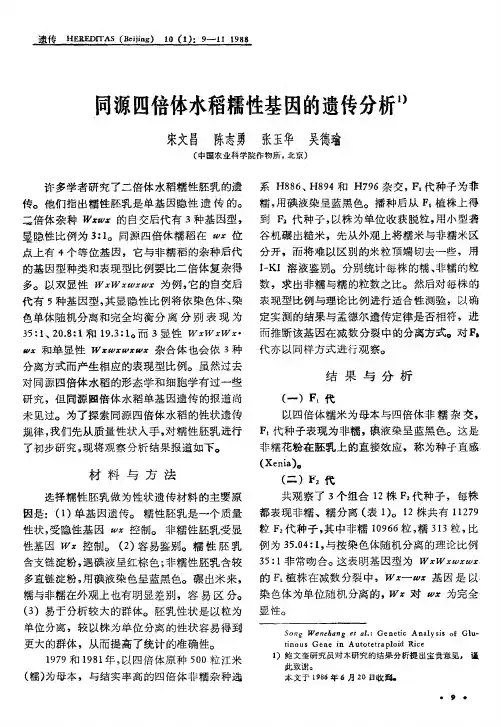
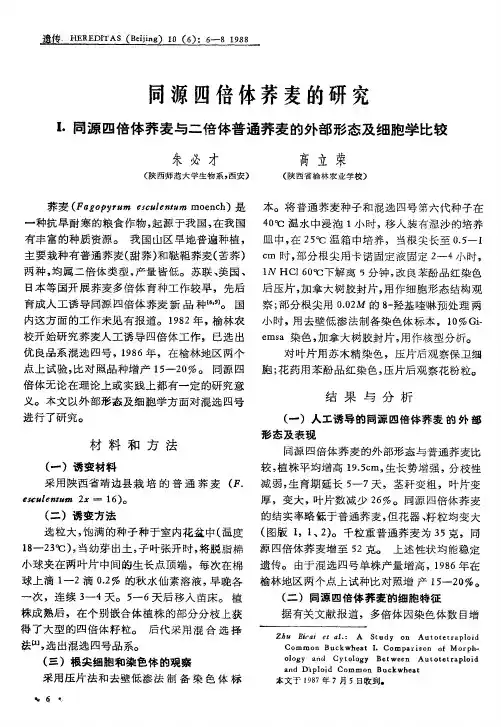
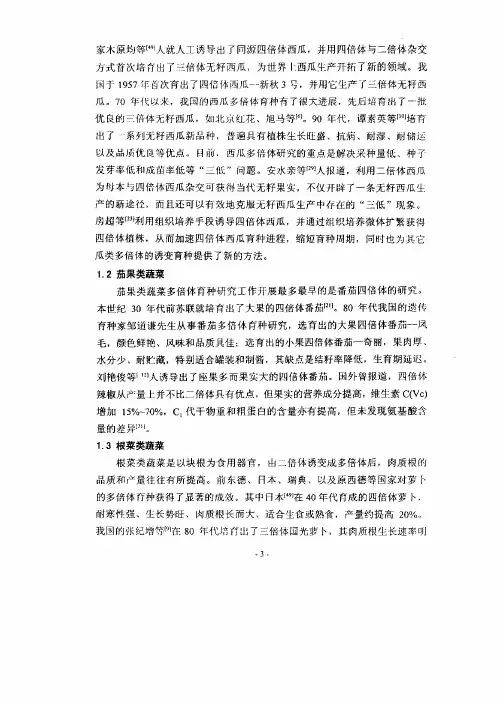
家术原均等【4q’人就人工诱导出了同源四倍体西瓜,并用四倍体与二倍体杂交方式首次培育出了三倍体无籽西瓜,为世界卜西瓜生产开拓了新的领域。
我吲于1957年首次育出了四倍体两瓜~新秋31¨7并用它生产了三倍体无籽西瓜。
70年代以来,我国的西瓜多倍体育种有了很大进展,先后培育出了一批优良的i倍体无籽西瓜,如北京红花、旭马等【“。
90年代,谭素英等Ⅲ1培育出了‘系列无籽西瓜新品种,普遍具有植株生长旺盛、抗病、耐湿、耐储运以及品质优良等优点。
目前,西瓜多倍体研究的重点是解决采种量低、种予发芽率低和成苗率低等“三低”问题。
安水亲等m1人报道,利用二倍体西瓜为母本与四倍体西瓜杂交可获得当代无籽果实,不仪开辟了一条无耔西瓜生产的新途径,而且还可以有效地克服无籽西瓜生产中存在的“三低”现象。
房超等口3’利用组织培养手段诱导四倍体西瓜,并通过组织培养微体扩繁获得四倍体植株,从而加速四倍体西瓜育种进程,缩短育种周期,同时也为其它瓜类多倍体的诱变育种提供了新的方法。
1.2茄果类蔬菜茄果类蔬菜多倍体育种研究工作开展最多最早的是番茄四倍体的研究。
本世纪30年代前苏联就培育出了大果的四倍体番茄Ⅲl。
80年代我国的遗传育种家邹道谦先生从事番茄多倍体育种研究,选育出的大果四倍体番茄一凤毛,颜色鲜艳、风味和品质具佳;选育出的小果四倍体番茄一奇丽,果肉厚、水分少、耐贮藏,特别适合罐装和制酱,其缺点是结籽率降低,生育期延迟。
刘艳俊等i”’人诱导出了座果多而果实大的四倍体番茄。
国外曾报道,四倍体辣椒从产量上并不Lg--倍体具有优点,但果实的营养成分提高,维生素C(Vc)增加15%~70%,C.代干物重和粗蛋白的含量亦有提高,但未发现氨基酸含量的差异”“。
1.3根菜类蔬菜根菜类蔬菜是以块根为食用器官,由二倍体诱变成多倍体后,肉质根的品质和产量往往有所提高。
前东德、日本、瑞典、以及原西德等国家对萝f、的多倍体育种获得了显著的成效。
遗 传HEREDITAS (Beijing ) 28(9): 1185~1190, 2006专论与综述收稿日期: 2005-09-28; 修回日期: 2006-04-24基金项目: 国家自然科学基金项目(编号: 30471412)、北京林业大学研究生基金项目(编号: 05jj038) [Supported by National Nature Science Foundation of China (No.30471412)and Financially supported by Graduate Fund of Beijing Forestry University ( No.05jj038)]作者简介: 姜金仲(1958—), 男, 河南上蔡人, 硕士, 高级讲师, 研究方向: 遗传育种, 生物技术。
jjz9911@ 植物同源四倍体生殖特性及DNA 遗传结构的变异姜金仲, 李 云, 程金新(北京林业大学生物科学与技术学院, 林木花卉遗传育种教育部重点实验室, 北京 100083)摘 要: 由于染色体加倍过程中的加倍因素和非加倍因素的影响, 同源四倍体的DNA 遗传结构较其起源二倍体产生了变异, 进而导致其表现型发生相应的变异。
和其起源二倍体相比, 同源四倍体的表现型变异表现在以下几个方面: 雌雄配子育性降低; 花粉(2n)的体积明显增大; 部分胚囊内卵细胞、助细胞及反足细胞数目有所增减; 自交繁殖过程中, 花粉的萌发及生长速度较慢、花粉管的形态部分畸形、部分极核受精过程及受精细胞(与精核结合的极核或卵)的进一步发育状况异常; 大多数育性或结实率会有不同程度的降低, 但降低的程度有因自交繁殖世代的推移而逐渐减小的趋势; 就一些植物种类而言, 同源四倍体有较好的远缘杂交亲和性。
关键词: 同源四倍体; 生殖; 同功酶; 分子标记 中文分类号: Q943 文献标识码: A文章编号: 0253-9772(2006)09-1185-06Variation of Both DNA Genetic Structure and ReproductionTraits of Plant AutotetraploidJIANG Jin-Zhong, LI Yun, CHENG Jin-Xing(College of Biological Science and Biotechnology , Beijing Forestry University , Key Laboratory of Genetics and Breeding ofForest tree and Ornamental Plant , MOE , Beijing 100083, China )Abstract: Due to the effect of chromosome doubling, the DNA genetic structures of autotetraploid vary from its original diploid, and thus autotetraploid phenotype changes correspondingly. Compared with original diploid, the phenotype changes of autotetraploid were as follows. The part of its male and female gametes was of abortion. Its pollen (diplo-haplont) was significantly bigger. The number of egg cells or synergids or antipodal cells in its embryo sacs increases or reduces. While self-crossing procreation of it , pollen tubes and the fertilization processes of polar nucleus and the fertilized cells development were partly abnormal. Its reproductive capacity (or seed setting rate) dropped to some extents, which can be gradually improved with generations. For some plant species, it has a better cross-compatibility in distant hybridizations.Key word: autotetraploid; procreation; isozymes; molecular marker植物同源四倍体的生殖特性包括其雌雄配子的育性、受粉受精过程、减数分裂、远缘杂交亲和性等方面的内容, 由于染色体倍性的变化, 植物同源四倍体在前述几个方面(表现型)较其起源二倍体均有所差异, 是为生殖特性变异。